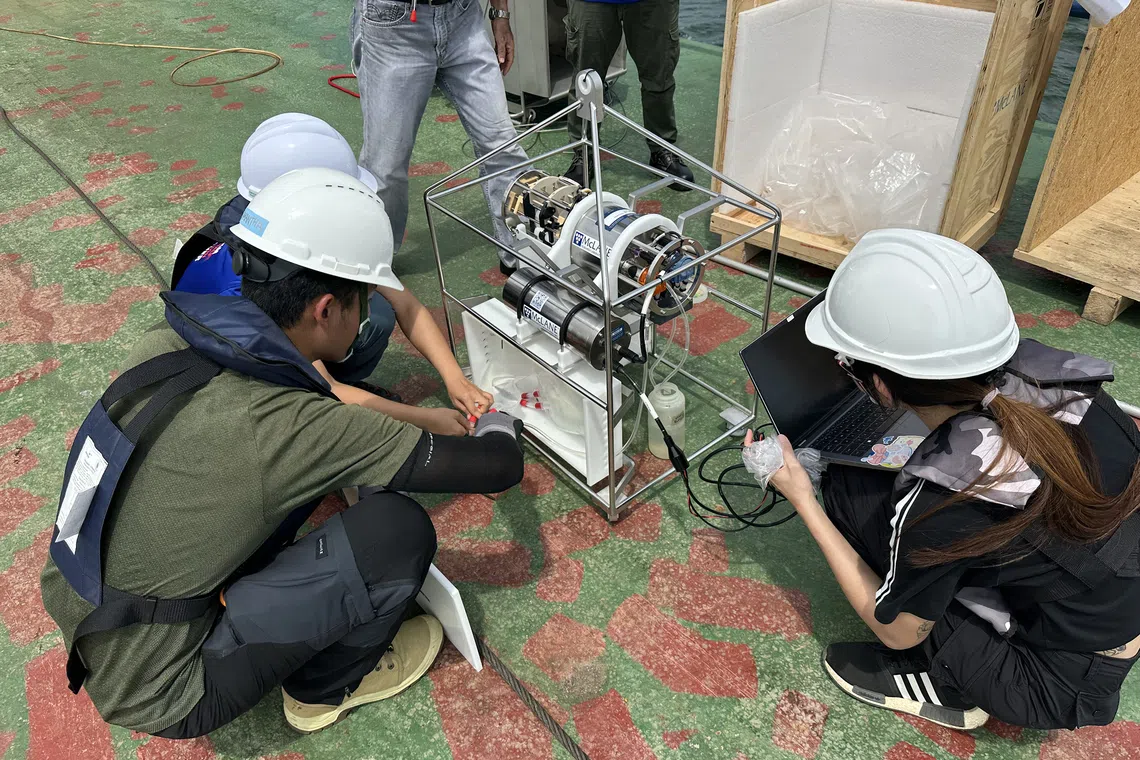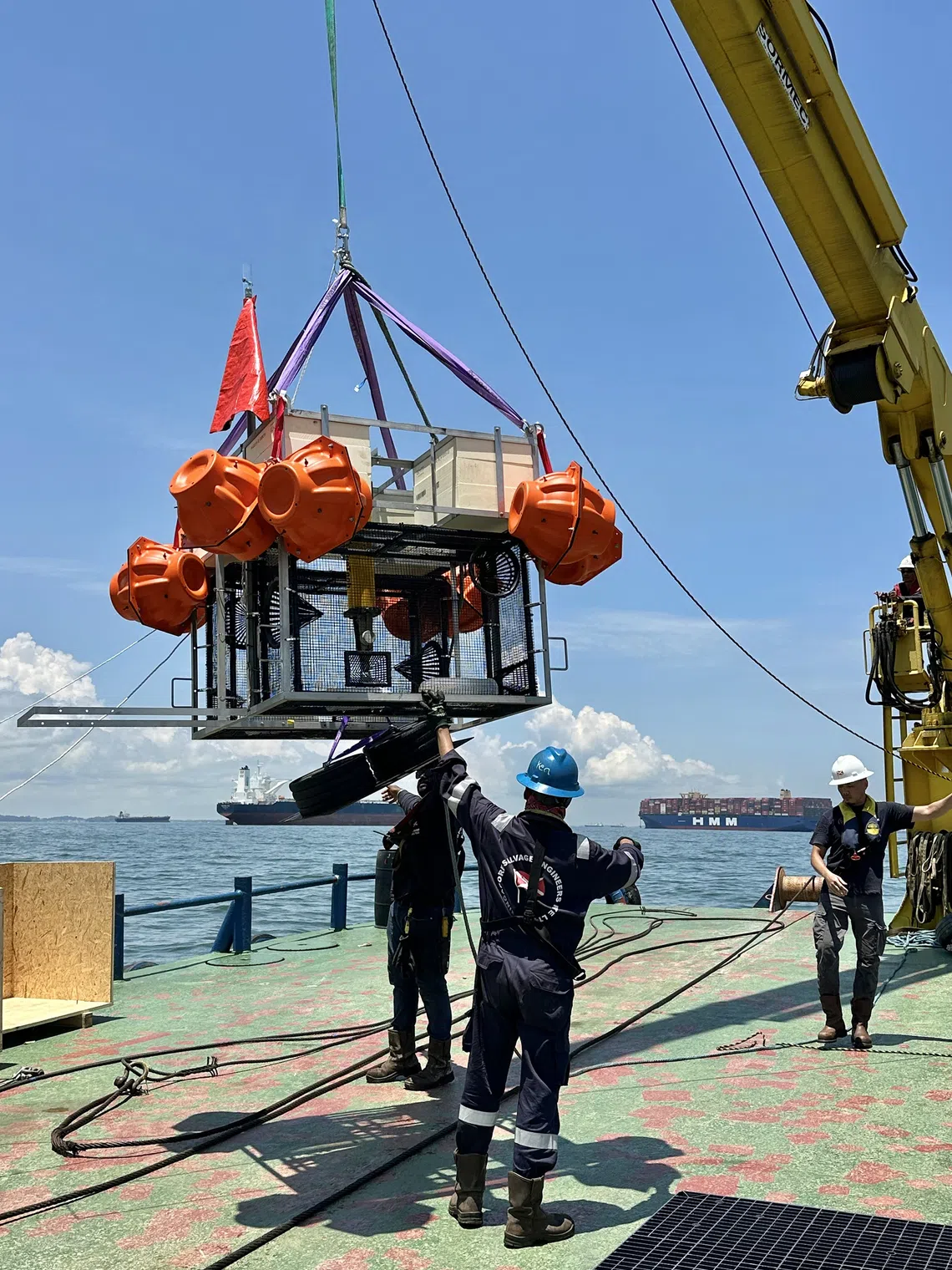NUS scientists gear up for high seas expedition to explore Indian Ocean seamount biodiversity
Sign up now: Get ST's newsletters delivered to your inbox

NUS researchers testing out an eDNA sampling machine. This technology enables researchers to detect traces of genetic material from coastal ecosystems even in deep waters.
PHOTO: NUS
Follow topic:
SINGAPORE – Marine scientists from the National University of Singapore (NUS) are preparing for a research foray to international waters in October, with plans to use novel technologies to learn more about seamounts in the eastern Indian Ocean.
Seamounts are underwater mountains known to be oases of biodiversity, said Dr Tan Koh Siang, who heads the marine biology and ecology laboratory at the NUS Tropical Marine Science Institute.
But of the estimated 14,000 seamounts globally, fewer than 500 have been examined, added Dr Tan, who is part of the 21-member research team from Singapore and the region.
“A key objective of the expedition is to characterise marine life in this part of the Indian Ocean that is poorly known and to focus on seamounts as far as possible,” he told The Straits Times in early September.
The expedition was announced by Minister for Foreign Affairs Vivian Balakrishnan during the UN Ocean Conference in June.
He said Singapore scientists will be going in October on a deep sea expedition with US-based, non-profit OceanX, aboard its state-of-the-art OceanXplorer scientific vessel.
ST reported then that the 3½-week expedition will take place in the international waters of the Christmas Island Seamount Province.
The deepest depths that will be explored will be about 4,000m. The waters around Singapore have depths of between 20m and 40m.
Dr Tan said the expedition will mark the research team’s first sortie into exploring seamount biodiversity.
When deep ocean currents strike a seamount, an upwelling of nutrient-rich water occurs, he noted.
This could cause a proliferation of plankton, the microscopic base of many oceanic food chains.
Their presence in turn supports distinct and complex food webs in the area associated with high biodiversity, he added.
The expedition’s chief scientist, Professor Peter Ng, from NUS’ department of biological sciences, said that to investigate these relationships, the researchers plan to use techniques and technologies that have not been used in past research cruises.
While many research efforts employ methods such as trawling to investigate life at depth, the expedition, he added, will tap the OceanXplorer’s high-tech abilities, such as remotely operated underwater vehicles.
Other research trips have previously been conducted by NUS scientists to study marine life in the waters around Singapore, Java Sea
The expedition will be co-funded by NUS and OceanX, Prof Ng added, with the National Research Foundation committing up to $6 million for the research programme.
He said there are plans to study the plankton community throughout the water column up to 2,000m, and survey fish life in the inky depths with specially constructed traps.
“We have to be careful about the traps that we deploy. If not, the bigger fish will eat the smaller fish, and the only way we can study the smaller fish is in the gut of the larger fish,” he added.
The researchers have devised a special system of “traps within a trap” to ensure that smaller fish can hide from their predators, he said.
Another innovation being piloted is the use of environmental DNA (eDNA) technology, which can detect traces of genetic material from coastal ecosystems, such as seagrasses or mangroves, even in deep waters.
This will allow scientists to detect the sources of carbon in the deep sea.
The deep ocean is theorised to be one of the world’s largest carbon vaults, locking up carbon and preventing it from reaching the atmosphere where it can drive climate change, said NUS marine biologist Huang Danwei. He is deputy head of the university’s Lee Kong Chian Natural History Museum and co-principal investigator of the upcoming scientific venture.
“Using trace DNA, or eDNA, left behind by seagrasses, mangroves and seaweed, we can detect levels and the sources of carbon that are being stored in the deep-sea environment,” he added.
By determining the amount of the carbon from coastal and surface habitats that make it into the deep sea vault, scientists can determine the effectiveness of the deep sea in mitigating the rise of atmospheric carbon dioxide driving climate change, he said.
Associate Professor Huang added that the eDNA technology will also allow them to identify species and estimate the abundance of wildlife in the area.
What is powerful about this technology is that scientists can detect the presence of these creatures without having to see them.
“Many of them may be too small or fast-moving and will evade conventional sampling approaches,” he noted. “eDNA will cover these gaps in biodiversity sampling, to detect signatures of elusive organisms present in the study site, such as sharks.”

NUS researchers testing out a special system of “traps within a trap” for the expedition.
PHOTO: NUS
The researchers said many of the technologies that will be used are “equally applicable” to shallow waters. The experiences gained will equip participants to use the same tools to sample and understand marine biodiversity and ecological processes closer to land.
Prof Ng added: “For Singapore, we are using these technologies and techniques for the first time – so it’s not just data gathering but also capacity building for our scientists.”
The high seas refer to the oceanic areas outside of any country’s jurisdiction.
The United Nations Convention on the Law of the Sea (Unclos) sets out the legal framework for all activities carried out in the oceans and seas.
In 2023, Singapore helped to broker an agreement
The treaty, dubbed the BBNJ (Biodiversity Beyond National Jurisdictions) Agreement, will enter into force after 60 countries ratify it. This threshold was reached earlier in September
The treaty will pave the way for broader ocean governance, including the establishment of marine protected areas in the high seas.
It could inform ongoing negotiations on deep-sea mining, as the BBNJ Agreement aims to, among other things, further discussions on environmental impact assessments by ensuring that relevant activities are evaluated to prevent or manage adverse impacts to the marine environment.
Even though no licences have been issued yet for commercial mining in the high seas, US President Donald Trump has taken steps towards issuing permits
Asked how the upcoming expedition could fit into global discussions on this issue, Dr Tan said seamounts are present in areas where deep-sea mining is expected to take place.
“However, this ecosystem has not been given sufficient attention, and the expedition will provide a glimpse of seamount biodiversity in the eastern Indian Ocean,” he added.
Prof Ng said the team is not expecting to find nodules – potato-sized rocks rich in critical metals found on the seabed – or other mineral resources that can be mined.
“We are mindful of the fact that deep-sea mining is a controversial topic. In an ideal world, we should not do this,” he added, though he acknowledged that some countries still want to keep the option on the table.
“My take is that if – and that is a very big if – we do undertake this, we must have strong environmental management mechanisms in place to minimise damage.
“My preference, of course, would be to leave these precious habitats alone,” Prof Ng said.


